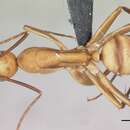en
names in breadcrumbs


The first record of the ants in Hawaii was published by Forel (1899) under the unavailable quadrinomial Camponotus maculatus r. mitis var. hawaiensis. The first available name given to these ants was Camponotus variegatus subsp. hawaiensis Emery. Wilson and Taylor (1967), realizing that the Hawaii population was likely recently derived from the introduction of an Asian species, synonymized C. variegatus subsp. hawaiensis with Camponotus variegatus (Smith, F.).
Reimer (1994) reported that Camponotus variegatus has only been collected in dry and mesic areas below 500 m where it is quite common, but qualifies the known distribution by noting that its nocturnal activity reduces the chances of detection during daytime surveys (the species is the only exclusively nocturnal ant species in Hawaii). Wheelers (1934) collection from Hawaii at 1300 m suggests the species may have been more widespread at higher elevations prior to the introduction of other ant species.
Native range. Asia. Introduced range. Hawaii (all main islands, and some of the Northwest Hawaiian Islands).
Diagnosis among workers of introduced and commonly intercepted ants in the United States. Worker caste polymorphic. Antenna 12-segmented. Antennal club indistinct. Antennal scape length less than 1.5x head length. Eyes medium to large (greater than 5 facets); lacking distinct ocelli. Antennal sockets and posterior clypeal margin separated by a distance equal to or greater than the minimum width of antennal scape. Head length longer than head width. Propodeum and petiolar node both lacking a pair of short teeth. Propodeum not angulate and lacking a distinct dorsal and posterior face; also lacking posteriorly projecting protrusion. Metapleuron lacking a distinct gland orifice. Waist 1-segmented. Petiole upright and not appearing flattened. Gaster armed with acidopore; variegated with dark transverse bands running near posterior margins of tergites that contrast with the paler yellow of the rest of gaster and body. Distinct constriction not visible between abdominal segments 3+4. Hairs not long thick and produced in pairs. Erect hairs relatively sparse on head and mesosoma.
Camponotus variegatus is diagnosed from other members of the genus introduced or commonly intercepted in the United States by the following characters: (1) metanotal groove not distinctly impressed (versus C. sexguttatus); ); (2) long erect hairs sparse on head and mesosoma (versus abundant in C. atriceps and C. planatus); (3) propodeum not angulate and lacking a distinct dorsal and posterior face (versus C. rectangularis); (4) gaster variegated with dark transverse bands running near posterior margins of tergites that contrast with the paler yellow of the rest of gaster and body (versus with distinct whitish spots (some C. sexguttatus) or concolorous (all others)).
Camponotus variegatus is a large yellowish brown species most easily recognized by the posterior margins of gastral tergites which are marked by subtriangular, medium brown infuscations that contrast sharply with the anterior portions of the tergites. The species is likely part of a taxonomically unresolved complex native to Southeast Asia (Wilson & Taylor, 1967), where many of the infraspecific taxa were described from (Bolton et al., 2006). It has established introduced populations across all of Hawaiis main islands, and some of the Northwest Hawaiian Islands. In Hawaii it is considered a pest species, and is found nesting in and around houses (Forel, 1899; Reimer et al., 1990).
Extant: 15 valid subspecies
Formica variegata Smith, 1858a PDF: 19 (w.q.) SRI LANKA. Indomalaya. AntCat AntWiki HOLTaxonomic history
Imai et al., 1984 PDF: 9 (k.).Combination in Camponotus: Mayr, 1862 PDF: 656.Combination in Camponotus (Myrmoturba): Forel, 1913l PDF: 125.Combination in Camponotus (Tanaemyrmex): Emery, 1925d PDF: 95.Subspecies of Camponotus sylvaticus: Mayr, 1880 PDF: 21.Subspecies of Camponotus maculatus: Forel, 1886h PDF: 149.Revived status as species: Dalla Torre, 1893 PDF: 256; Santschi, 1920h PDF: 173; Emery, 1920d 10.5281/zenodo.25547 PDF: 7.Senior synonym of Camponotus variegatus hawaiensis: Wilson & Taylor, 1967b PDF: 95.[[ worker ]] Laenge: 9 - 11 mm. Die groesseren Arbeiter sind gelb, roethlichgelb oder braeunlichgelb, der Kopf, mit Ausnahme der rothgelben Geissel und der Hinterleib sind braunschwarz, der letztere ist an der Basis, sowie vorzueglich an den beiden Seiten des ersten und zweiten Segmentes mit einem gelben Flecke versehen, jedoch ist der Hinterleib bei den groessten Exemplaren ganz schwarz; der Thorax ist oben dunkelbraun, das Ende der Schenke], die Schienen und die Tarsen sind mehr oder weniger braeunlichroth. Die kleineren Arbeiter sind gewoehnlich roethlichgelb, der Kopf ist rothbraun, die Fuehler ganz rothgelb, der Hinterleib ist wie bei den groesseren [[ worker ]], nur mit der Aenderung, dass die Flecken oft sehr verwischt sind. Die abstehende Behaarung ist sehr spaerlich, so dass sich an der Oberseite des Thorax kaum ein Dutzend Haare, oder bei den groessten Stuecken fast gar keine Haare vorfinden; am Hinterleibe stehen diese Borstenhaare in ziemlich regelmaessigen Reihen, und zwar eine Reihe am Grunde und eine am Ende eines jeden Segmentes. Die anliegende Pubescenz fehlt fast. Die Mandibeln sind matt, weitlaeufig grob punctirt und besonders an der Endhaelfte sehr fein und dicht laengsgestreift. Der Clypeus ist so wie der ganze, nur an den Seiten glaenzende Kopf fein lederartig gerunzelt und seicht, bei kleinen Exemplaren undeutlich zerstreut punctirt; der Clypeus ist gekielt und sein Vorderrand ist gewoehnlich maessig, bei den groessten Stuecken aber nur sehr wenig vorgezogen und beiderseits ausgebuchtet. Der Thorax ist sehr fein und dicht streifig gerunzelt, sehr undeutlich zerstreut seicht punctirt, oben matt und an den Seiten ziemlich glaenzend. Die Schuppe ist eifoermig, oben abgerundet etwas niedriger als bei C. marginatus , mit welchem diese Art viele Aehnlichkeit hat, und dicker; bei den groessten Exemplaren hat die Schuppe, oben einen duennschneidigen Rand. Der Hinterleib glaenzt maessig, ist dicht und sehr fein quergestreift und die Streifen sind so unterbrochen, dass ein Streifen eigentlich aus einer Reihe aneinander gereihter Strichelchen besteht.
Im M. C. Vienn. aus Asien, und zwar aus Smyrna, Syrien, Amasia und den Sunda-Inseln.
Es ist nicht unwahrscheinlich, dass Smith's F. callida mit dieser Art synonym ist.
Camponotus variegatus is a species of carpenter ant (genus Camponotus).
They will eat small insects, honeydew, and most common pantry foods.[1]
Camponotus variegatus is a species of carpenter ant (genus Camponotus).